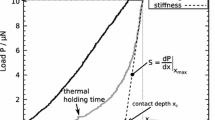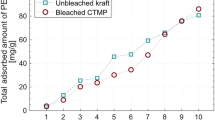Abstract
The influence of charged species on the relative bonded area (RBA) of flat shaped viscose fibre handsheets was investigated. For this purpose four samples, a reference fibre without any additives as well as three physical modified fibres, were studied. The RBA was determined by the light scattering method and by using the so called Page equation. To use the Page equation, the breaking length of handsheets, the optical bonded area of fibre-fibre joints as well as the bond strength of such fibre joints were determined. The optical bonded area was analysed by polarized light microscopy. Using a micro bond tester, the bond strength of fibre-fibre joints was determined. Both techniques, light scattering and calculation via the Page equation did not deliver absolute values for RBA. Quite contrary, they only give approximate values. However, an increase of relative bonded area due to anionic charges is clearly seen. Additionally, the breaking length is increased by both additives.









Similar content being viewed by others
References
Abu-Rous M, Ingolic E, Schuster KC (2006) Visualization of the fibrillar and pore morphology of cellulosic fibres applying transmission electron microscopy. Cellulose 13:411–419
Bartsch H-J (2001) Taschenbuch mathematischer Formeln, vol. 19. Fachbuchverlag Leipzig
Batchelor W, He J (2005) A new method for determining the relative bonded area. Tappi 4(6):23–28
Belser RB, Taylor J (1968) Frictinal properties of cotton fibres. Gerorgia Institute of Technology Reports, (6)
Bernt I (2010a) Fine-tuning of paper characteristics by incorporation of viscose fibres. In: Zellcheming-Hauptversammlung
Bernt I (2010b) WO2011012422 (A1)—use of a regenerated cellulose fibre in a flame-retardant product
Calistru E, Ciovica S (1968) Recent advances in the regenerated cellulose fibre industry. Celuloza Hirtie 17(4):137–141
Duker E, Lindström T (2008) On the mechanisms behind the ability of CMC to enhance paper strength. Nord Pulp Paper Res J 23(1):57–64
Fischer W, Hirn U, Bauer W (2012) Testing of individual fibre-fibre joints under biaxial load and simulaneous analysis of deformation. Nord Pulp Paper Res J 27(2):237–244
Ganser C, Hirn U, Rohm S, Schennach R, Teichert C (2014) AFM nanoindentation of pulp fibers and thin cellulose films at varying relative humidity. Holzforschung 68(1):53–60
Gilli E, Kappel L, Hirn U, Schennach R (2009) An optical model for polarization microscopy analysis of pulp fibre-to-fibre bonds. Compos Interfaces 16:901–922
Gobrecht J (2009) Werkstofftechnik - metalle. Oldenbourg Wissenschaftsverlag GmbH
Haselton W (1955) Gas adsorption by wood, pulp, and paper II. The application of gas adsorption techniques to the study of the area and structure of pulps and the unbonded and bonded area of paper. Tappi 38(12):716–723
Ingmanson W, Thode E (1959) Factors contributing to the strength of a sheet of paper II. Relative bonded area. Tappi 42(1):83–93
Kallmes O, Ecker C (1964) The strucutre of paper VII. The application of the raltive bonded area concept to paper evaluation. Tappi 47(9):540–548
Kappel L, Gilli E, Bauer W, H U, Schennach U (2010a) Resiting polarized light microscopy for fibrer-fiber bond area measurement—part 1: theoretical fundamentals. Nord Pulp Pap Res J 25:65–70
Kappel L, Hirn U, Bauer W, Schennach R (2009) A novel method for the determination of bonded area of individual fiber-fiber bonds. Nord Pulp Pap Res J 24(2):199–205
Kappel L, Hirn U, Gilli E, Bauer W, Schennach R (2010b) Revisiting polarized light microscopy for fiber-fiber bond area measurement—part 2: proving the applicability. Nord Pulp Pap Res J 25:71–75
Kontturi K, Tammelin T, Johansson L-S, Stenius P (2008) Adsorption of cationic starch on cellulose studied by QCM-D. Langmuir 24:4743–4749
Krässig H, Schurz J, Steadmann RG, Schiefer K, Albrecht W (1986) Ullmann’s encyclopia of industrial chemistry, vol 6, 5th edn. VCH, Weihnheim
Laine J, Lindström T, Bremberg C, Glad-Nordmark G (2003) Studies on topochemical modification of cellulosic fibres part 5. Comparison of the effects of surface and bulk chemical modification and beating of pulp and paper properties. Nord Pulp Pap Res J 18(3):325–332
Laine J, Lindström T, Nordmark GG, Risinger G (2002) Studies on topochemical modification of cellulosic fibres part 2. The effect of carboxymethyl cellulose attachment on fibre swelling and paper strength. Nord Pulp Pap Res J 17(1):50–56
Lindström T, Wagberg L, Larsson T (2005) On the nature of joint strength in paper—a review of dry and wet strength resins used in paper manufacturing. In: Advances in paper science and technology—transactions of the 13th fundamental research symposium held at Cambridge
Ozturk HB, Bechtold T (2008) Splitting tendency of cellulosic fibers part 3: splitting tendency of viscose and modal fibers. Cellulose 15:101–109
Page D (1969) A theory for the tensile strength of paper. Tappi 52(4):674–681
Parsons S (1942) Optical characteristics of paper as a function of fiber classification. Pap Trade J 115(25):34–42
Persson B, Ganser C, Schmied F, Teichert C, Schennach R, Gilli E, Hirn U (2013) Adhesion of cellulose fibers in paper. J Phys Condens Matter 25:1–11
Rohm S, Hirn U, Ganser C, Teichert C, Schennach R (2014) Thin cellulose films as a model system for paper fiber bonds. Cellulose 21(1):237–249
Schmied F, Teichert C, Kappel L, Hirn U, Bauer W, Schennach R (2013) What holds paper together:Nanometre scale exploration of bonding between paper fibres. Sci Rep 3:2432
Sisson W (1960) The spinning of rayon as related to its structure and properties. Text Res J 30(3):153–170
Smith F (1980) US4199367 A—Alloy rayon
Stratton R, Colson N (1990) Dependence of fiber/fiber bonding on some papermaking variables. In: IPTS technial paper series, pp 1–19
van den Akker J, Lathrop A, Voelker M, Dearth L (1958) Importance of fibre strength to sheet strength. Tappi 41(8):416–425
Weber F (2014) Viscose fibres—-a model system to investigate the influence of charge on the properties of handsheets and fibre-fibre joints. PhD thesis, Graz University of Technology
Weber F, Koller G, Schennach R, Bernt I, Eckhart R (2013) The surface charge of regenerated cellulose fibres. Cellulose 20(6):2719–2729
Author information
Authors and Affiliations
Corresponding authors
Rights and permissions
About this article
Cite this article
Weber, F., Ganser, C., Teichert, C. et al. Application of the page-equation on flat shaped viscose fibre handsheets. Cellulose 21, 3715–3724 (2014). https://doi.org/10.1007/s10570-014-0389-x
Received:
Accepted:
Published:
Issue Date:
DOI: https://doi.org/10.1007/s10570-014-0389-x




